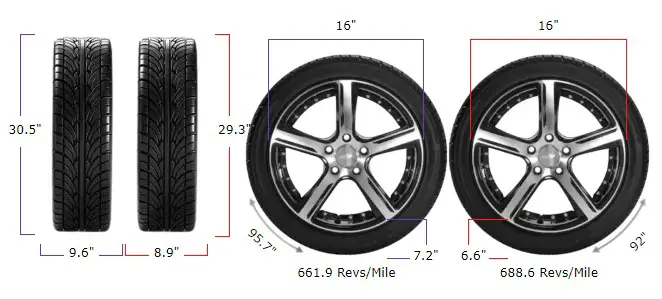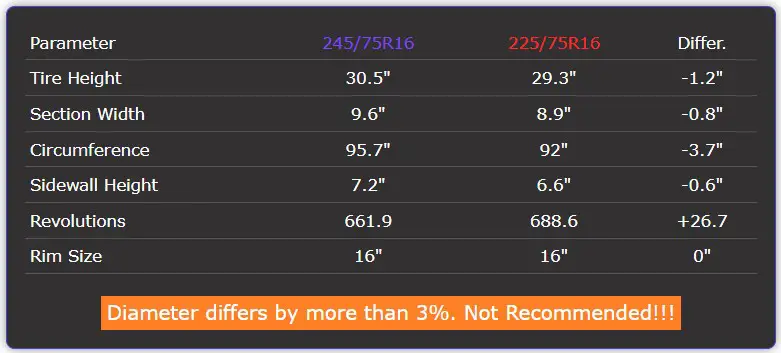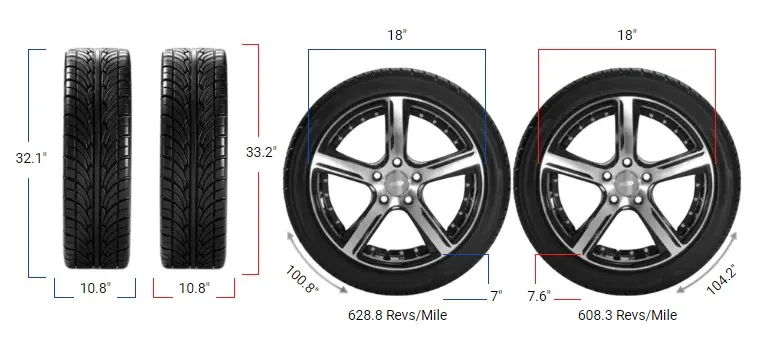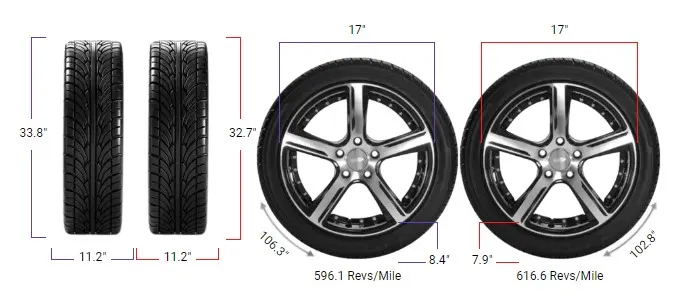Tire Size 245/75r16 vs 225/75r16

Thinking about changing your tires? Switching from 245/75r16 to 225/75r16 can impact your vehicle in several ways. Let’s explore what this change means for your driving experience.
- The 225/75R16 has a smaller diameter, reducing ground clearance.
- A narrower width can improve fuel efficiency.
- The reduced sidewall height may provide a firmer ride.
- Switching to a smaller tire can enhance handling in some conditions.
- A decrease in circumference may affect speedometer accuracy.
- The 225 tire may reduce road noise for a quieter ride.

Fitment Guide
The replacement tires should be within 3% of the original diameter. The diameter difference here is -3.9%, which exceeds the acceptable range.
Therefore, switching to a 225/75r16 is not recommended without making necessary adaptations to prevent issues like rubbing or clearance problems.
On-Road Impact
Changing tire size can significantly affect how your vehicle performs on regular roads. Here’s how switching to 225/75r16 tires impacts on-road performance:

- Ground Clearance: Reducing the diameter by 1.18 inches (30 mm) decreases your vehicle’s ground clearance. This can make it easier to maneuver in tight spaces but may increase the risk of scraping on speed bumps or uneven roads.
- Gas Mileage: Narrower tires like the 225/75r16 are lighter, which can slightly improve fuel efficiency. With a 4% increase in revolutions per mile, your engine may work a bit more efficiently, potentially saving a few miles per gallon.
- Aesthetic Look: Switching to narrower tires gives your vehicle a sleeker and more streamlined appearance. This can enhance the overall look, making it appear less bulky and more sporty.
- Ride Comfort: The reduced sidewall height (a 7.1% decrease) means there is less cushioning between the wheel and the road. This can result in a slightly firmer ride, making bumps and potholes more noticeable.
- Speedometer Accuracy: With a smaller circumference, your speedometer will read higher than your actual speed. For example, when your speedometer shows 20 mph, you’re actually traveling at 19.22 mph. This can lead to unintentional speeding if not adjusted.
- Handling: Narrower tires generally offer better handling on dry roads due to reduced rolling resistance. However, the decrease in diameter can slightly affect the steering response and stability at higher speeds.
- Durability & Wear: The 225/75r16 tires may wear differently compared to the 245/75r16. Proper maintenance, including regular rotation and correct tire pressure, is essential to ensure even wear and extend tire life.
Off-Road Impact
If you enjoy off-roading, changing to 225/75r16 tires can also influence your vehicle’s performance in those conditions. Here’s what to consider:

- Traction: The narrower footprint of the 225/75r16 can improve grip on certain off-road surfaces like rocky trails or hard-packed dirt. However, it may reduce traction on loose surfaces like mud or sand compared to wider tires.
- Obstacle Navigation: With a smaller diameter, your tires may not roll over obstacles as easily as larger ones. This can make navigating rocks and logs more challenging, potentially increasing the risk of getting stuck.
- Clearance Issues: Although the diameter is smaller, the overall change still exceeds the recommended limit, which may still cause rubbing against wheel wells or suspension components during extreme articulation. Additional modifications might be necessary to prevent damage.
- Vehicle Stress: Reducing tire size can lessen the strain on your vehicle’s drivetrain and brakes compared to larger tires. However, the change in handling dynamics still requires careful consideration to maintain vehicle balance and performance.
- Tire Pressure Adjustments: Off-roading often requires different tire pressure settings. The 225/75r16 tires may need specific pressure adjustments to perform effectively without risking damage or reduced traction.
245/75r16 vs 225/75r16
This table compares the key features of tire sizes 245/75R16 and 225/75R16.
| Feature | 245/75R16 | 225/75R16 | Difference |
|---|---|---|---|
| Diameter inches (mm) | 30.47 (773.9) | 29.29 (743.9) | -1.18 (-30) -3.9% |
| Width inches (mm) | 9.65 (245) | 8.86 (225) | -0.79 (-20) -8.2% |
| Circumference inches (mm) | 95.72 (2431.28) | 92.01 (2337.03) | -3.71 (-94.25) -3.9% |
| Sidewall Height inches (mm) | 7.23 (183.75) | 6.64 (168.75) | -0.59 (-15) -8.2% |
| Revolutions per mile (km) | 661.93 (411.31) | 688.63 (427.89) | 26.69 (16.59) 4% |
| Speedo Reading | 20 mph (32.19 km/h) | 19.22 mph (30.94 km/h) | -0.78 mph |
Difference Between 245/75R16 and 225/75R16
The main difference is width; the 245/75R16 tire is 0.79 inches (20 mm) wider than the 225/75R16, providing a broader contact patch and improved stability.
Can I Use 225/75R16 Instead of 245/75R16?
Yes, but the 225/75R16 tire is 3.9% smaller in diameter, which may impact speedometer accuracy, handling, and ground clearance. Ensure your vehicle can accommodate the smaller size.
How Much Taller Is a 245/75R16 Tire Than a 225/75R16?
The 245/75R16 tire is 1.18 inches (30 mm) taller than the 225/75R16, offering more ground clearance.
How Much Wider is a 245/75R16 Tire Than a 225/75R16?
The 245/75R16 tire is 0.79 inches (20 mm) wider than the 225/75R16, giving a wider footprint for better traction.
Our Observation
Switching from 245/75r16 to 225/75r16 presents both benefits and drawbacks. On-road, you may enjoy improved fuel efficiency and a sleeker appearance due to the narrower tires.
The slightly higher revolutions per mile can enhance engine efficiency, while the reduced width can offer better handling on dry roads.
However, the 3.9% decrease in diameter exceeds the recommended limit, potentially causing speedometer inaccuracies and reduced ground clearance.
The firmer ride from lower sidewalls might make bumps more noticeable, and the smaller size can slightly affect stability at higher speeds.
Off-road, the narrower tires provide better grip on hard surfaces but may struggle with loose terrains and obstacle navigation. Clearance issues can still arise without proper vehicle modifications.
Overall, the differences are notable and should be carefully weighed. While some changes, like improved aesthetics and fuel efficiency, are beneficial, others, such as handling and speedometer accuracy, require attention.
If you decide to make the switch, ensure necessary adaptations are made to maintain safety and performance both on-road and off-road.



